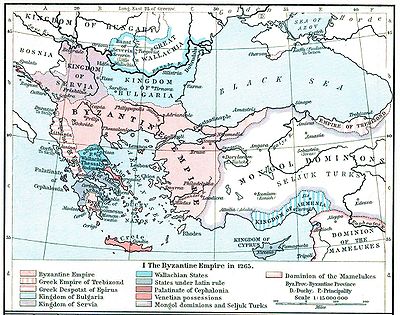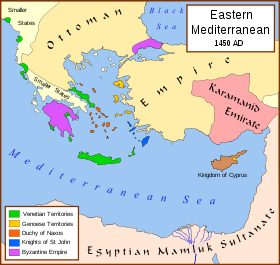- Duchy of the Archipelago
-
Duchy of the Archipelago
Ducato dell'arcipelago
Δουκᾶτον ἈρχιπελάγουςClient state* ← 
1207–1579  →
→Coat of Arms of the Duchy of the Archipelago
Duchy of Naxos, 1450, highlighted within the Aegean Sea Capital Naxos Language(s) Venetian officially,
Greek popularlyReligion Roman Catholic,
Greek Orthodox popularlyGovernment Principality Duke - 1207–27 Marco I Sanudo - 1383–97 Francesco I Crispo - 1564–66 Giacomo IV Crispo - 1566–79 Joseph Nasi Historical era Middle Ages - Fourth Crusade 1201–03 - Duchy established 1207 1207 - Crispo coup d'état 1383 - Ottoman conquest 1566 - Expropriated by Selim II 1579 1579 * The duchy was a client state of, in order, the Latin Emperors at Constantinople, the Villehardouin dynasty of princes of Achaea, the Angevins of the Kingdom of Naples and (after 1418) the Republic of Venice. From 1566–79, the duchy was administered as a part of the Ottoman Empire before total annexation. The Duchy of the Archipelago (Italian: Ducato dell'arcipelago, Greek: Δουκάτον Αρχιπελάγους) or also Duchy of Naxos (Italian: Ducato di Nasso, Greek: Δουκάτον Νάξου) or Duchy of the Aegean (Italian: Ducato dell’ Egeopelagi, Greek: Δουκάτον Αιγαίου) was a maritime state created by Venetian interests in the Cyclades archipelago in the Aegean Sea, in the aftermath of the Fourth Crusade, centered on the islands of Naxos and Paros.
Contents
Background and establishment of the Duchy
The Italian city states, especially the Republic of Genoa, Pisa, and the Republic of Venice, had been interested in the islands of the Aegean long before the Fourth Crusade. There were Italian trading colonies in Constantinople and Italian pirates frequently attacked settlements in the Aegean in the 12th century. After the collapse and partitioning of the Byzantine Empire in 1204, in which the Venetians played a major role, Venetian interests in the Aegean could be more thoroughly realized.
The Duchy of the Archipelago was created in 1207 by Marco Sanudo, a participant in the Crusade and a nephew of the former Venetian doge Enrico Dandolo, who had led the Venetian fleet to Constantinople. This was an independent venture, without the consent of the Latin emperor Henry of Flanders. Sanudo was accompanied by Marino Dandolo and Andrea and Geremia Ghisi, as well as Ravano dalle Carceri, lord of Euboea, and Philocalo Navigaioso, lord of Lemnos. He arranged for the loan of eight galleys from the Venetian Arsenal, set anchor in the harbor of Potamidides, in the southwest of Naxos, and largely captured the island.
The Greek Orthodox Naxiotes continued to resist, however, and established a base inland, around the fortress of Apalyros/Apalire. The latter fell to Sanudo after five or six weeks' siege, despite the assistance rendered to the Greeks by the Genoese, Venice's main competitors.
With the entire island occupied in 1210, Sanudo and his associaties soon conquered Melos and the rest of the islands of the Cyclades, and he established himself as Duke of Naxia, or Duke of the Archipelago, with his headquarters on Naxos. Sanudo rebuilt a strong fortress and divided the island into 56 provinces, which he shared out as fiefs among the leaders of his men, most of whom were highly autonomous and apparently paid their own expenses. Carceri and Navigaoiso had been granted their island domains by Henry of Flanders and were technically vassals of the Latin Empire; Sanudo himself recognized the Latin Empire's authority rather than making the Duchy a vassal of Venice.
The conqueror himself ruled for twenty years (1207–27). He held in his personal possession Paros, Antiparos, Melos, Sifnos, Kithnos, Ios, Amorgos, Kimolos, Sikinos, Syros, and Pholegandros. Other islands included Andros (held by Dandolo), Tinos, Mykonos, , Skiathos, Skyros, Skopelos, Serifos, Cea (held by the Ghisi brothers), Thera (held by Jacopo Barozzi), Anaphe (held by Leonardo Foscolo), Kythera (or Cerigo held by Marco Venier), and Antikythera (or Cerigotto, held by Jacopo Viaro).
 The Duchy of Naxos and states in the Morea, carved from the Byzantine Empire, as they were in 1265 (William R. Shepherd, Historical Atlas, 1911)
The Duchy of Naxos and states in the Morea, carved from the Byzantine Empire, as they were in 1265 (William R. Shepherd, Historical Atlas, 1911)
Administration, faith and economics
In effect, the substitution of a Latin feudalism caused little disruption to the Greek islanders, who were familiar with the rights of a landowner class under the similar Byzantine system of the pronoia. In most cases, they lived relatively peacefully with their new Venetian lords. Sanudo and his successors prudently followed a conciliatory course with their Greek subjects, granting even fiefs to certain among them, in an effort to bind them to the dynasty.
The Venetians brought the Catholic Church with them, but, as they were a minority of habitually absentee landowners, most Greeks remained Greek Orthodox. Marco Sanudo himself established a Latin archbishopric on Naxos, but in contrast to his successors did not attempt to forcibly convert the Greek Orthodox majority. These moves consisted primarily in imposing restrictions on Orthodox clergy and the exclusion of Orthodox Christians from positions of authority. Thus, the denominational division between Catholics and Orthodox gradually became a social division, with the Catholic ruling classes living in the towns on the islands and the Orthodox predominating in the countryside.
The major concerns of the Venetians in the Duchy were the valuable trade routes with the larger islands off of Anatolia, which they could now control; although those islands themselves remained part of the Latin Empire, and later the restored Byzantine Empire, until taken by the Ottoman Empire in the 14th century. Aside from providing safe traveling routes to Venetian ships, the Venetians also exported to Venice corundum and marble, which they mined on Naxos. Certain Latin feudal rights survived in the island of Naxos and elsewhere until they were abrogated in 1720 by the Ottomans.
Later history
The Annals of the Latin Archipelago center on the family histories of Sanudo and Dandolo, Ghisi, Crispo and Sommaripa, Venier and Quirini, Barozzi and Gozzadini. Twenty-one dukes of the two dynasties ruled the Archipelago, successively as vassals of the Latin Emperors at Constantinople, of the Villehardouin dynasty of princes of Achaea, of the Angevins of the Kingdom of Naples (in 1278), and after 1418 of the Republic of Venice.
In 1236, the Duchy was nominally granted to William of Villehardouin, later Prince of Achaea. Marco II Sanudo lost many of the islands, except Naxos and Paros, to the forces of the renewed Byzantine Empire under the admiral Licario in the late 13th century. The Byzantine revival was to prove short-lived though, as they relinquished control of their gains in 1310.
In 1317 the Catalan Grand Company raided the remnants of the Duchy; in 1383, the Crispo family led an armed insurrection and overthrew Sanudo's heirs as Dukes of Archipelago. Under the Crispo dukes, social order and agriculture decayed, and piracy became dominant.
Collapse and Ottoman conquest
Before the last Latin Christian duke, Jacopo IV Crispo, was deposed in 1566 by Ottoman Sultan Selim II, he was already paying the Sultan tribute. The Sultan's appointed representative, the last Duke of Archipelago (1566-79) was a Portuguese Jew (Marrano), Joseph Nasi.
Latin Christian rule was not entirely removed after that date: the Gozzadini family in Bologna survived as lords of Siphnos and other little islands in the Cyclades until 1617, and the island of Tenos remained Venetian until 1714. The last Venetian ports in Morea (the Peloponnese) were captured in 1718. Gaspar Graziani, a Dalmatian nobleman, was awarded the title of Duke of the Archipelago in 1616, but the island was again under direct Ottoman rule at the end of 1617; he was the last to hold the title.
Other Venetian territories in the Aegean
The Venetians controlled other islands as colonies, not as part of the Duchy or the Latin Empire. They bought Crete from Boniface of Montferrat, leader of the Fourth Crusade, in 1204, and from 1207 to 1211 the Venetians conquered it from the Maltese Enrico Pescatore (who had taken it in 1206). Jacopo Tiepolo was installed as the first duke.
Venice also controlled much of Euboea (Negroponte), where they had a trading colony, and controlled various ports on mainland Greece.
Dukes of the Archipelago
Sanudo dynasty
- Marco I Sanudo (1207–27)
- Angelo (1227–62)
- Marco II (1262–1303)
- Guglielmo I (1303–23)
- Niccolò I (1323–41)
- Giovanni I (1341–62)
- Fiorenza (1362–71)
- Niccolò II (1364–71)
- Niccolò III dalle Carceri (1371–83)
Crispo dynasty
- Francesco I Crispo (1383–97)
- Giacomo I (1397–1418)
- Giovanni II (1418–33)
- Giacomo II (1433–47)
- Gian Giacomo (1447–53)
- Guglielmo II (1453–63)
- Francesco II (1463-63)
- Giacomo III (1463–80)
- Giovanni III (1480–94)
(interregnum)
- Francesco III (1500–11)
(interregnum)
- Giovanni IV (1517–64)
- Giacomo IV (1564–66)
Ottoman representative
- Joseph Nasi (1566–79)
Genealogy
See also
- Byzantine Greece
Crusader States Levant Latin Greece Latin Empire · Kingdom of Thessalonica · Principality of Achaea · Duchy of Athens · Duchy of Neopatria · Duchy of the Archipelago · Lordship of Negroponte · County palatine of Cephalonia and Zakynthos · Lordship of Chios · Kingdom of Candia · Republic of Venice (Stato da Màr) · Knights HospitallerBaltic Categories:- Former principalities
- Former countries in the Balkans
- Former client states
- States and territories established in 1207
- States and territories disestablished in 1579
- 1579 disestablishments
- Duchy of the Archipelago
- Naxos (island)
- Crusader states
- Byzantine Empire successor states in the Balkans
Wikimedia Foundation. 2010.



